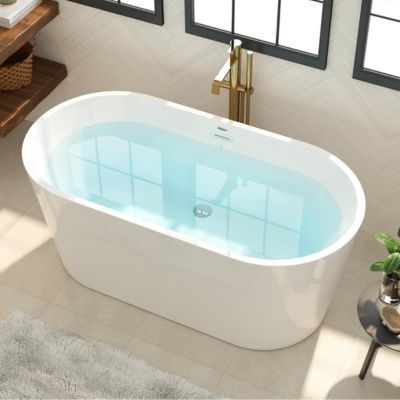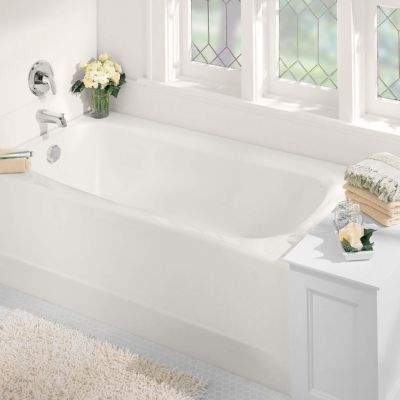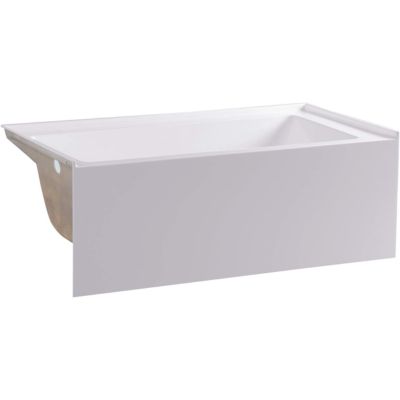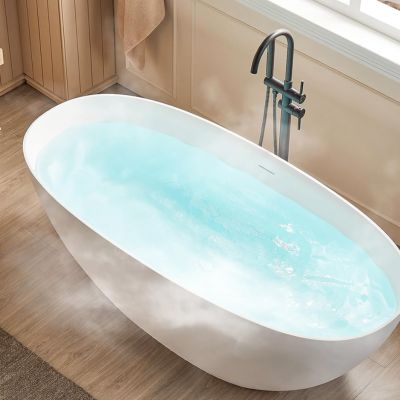If you’re like most homeowners, choosing a new bathtub likely isn’t something you do very often. But when it comes time to replace or upgrade your existing tub, you’ll want to make sure you select the right one for your needs. With so many types, sizes, features, and installation options available, it can get overwhelming trying to pick out the perfect bathtub.
In this comprehensive guide, I’ll walk you through everything you need to know before installing a new bathtub in your home. We’ll explore the different types of tubs, key features to look for, installation and maintenance tips, and ideas to create a relaxing, spa-like bathing experience. Let’s dive in!
What are the Different Types of Bathtubs?
When browsing bathtubs at your local home improvement store or in catalogs, you’ll notice there are quite a few options to choose from. The most common types of tubs are:

Best Acrylic Bathtub
FerdY Shangri-La 55″

Best Cast Iron Bathtub
Signature Hardware 144838 Erica 57″

Best Procelain-Enameled Steel Tub
American Standard 2460002.020

Best Fiberglass Soaking Bathtub
Fine Fixtures Bathtub 54″ x 30″

Best Stone Bathtubs
Cpingao 71″

Best Wooden Bathtub
Alfi Brand AB1130 65″
Acrylic Bathtubs
Acrylic tubs are among the most popular choices for homeowners today. They are made from molded acrylic-based plastic and reinforced with fiberglass. Acrylic is lightweight, durable, and available in a wide range of colors and styles. These tubs resist chipping and cracking better than other materials. With proper care, an acrylic tub can maintain its shiny, like-new appearance for years.
Cast Iron Bathtubs
Cast iron tubs have been around for over a century. They are extremely durable and retain heat very well, keeping bath water hotter for longer. These heavy tubs are coated with porcelain enamel on the interior and exterior. While prone to chipping if struck hard, cast iron tubs will easily last 50 years or more. They come in both vintage clawfoot styles and modern integrated designs.
Porcelain Enameled Steel Bathtubs
Porcelain enamel over steel combines the strength and affordability of steel with the glossy appeal of porcelain. This type of tub offers great durability and scratch resistance. Like cast iron, enameled steel also retains heat well. The porcelain enamel interior won’t fade or discolor over time. Just note that chips in the exterior paint coat may lead to rust if not repaired. Read more about the best bathtub rust removers.
Fiberglass Bathtubs
Fiberglass bathtubs are lightweight, affordable, and easy to install. They consist of molded fiberglass reinforced with resin. Most fiberglass tubs have an acrylic top layer for extra gloss and durability. Seamless fiberglass construction makes cleaning easy since grime and dirt can’t build up in crevices. Fiberglass tubs are available in almost any color. Just be aware they scratch more easily than other materials.
Stone Bathtubs
For an ultra-luxurious bathroom, you can opt for a genuine stone bathtub hand-carved from marble, granite, or natural stone. While heavy and expensive, stone tubs create a striking, spa-like focal point in the bathroom. Each stone tub is entirely unique with natural color variations. They offer unmatched elegance, but the material is prone to staining, scratching, and cracking if not handled with extreme care.
Wooden Bathtubs
Wooden tubs have an organic, rustic feel that brings the beauty of nature into the bathroom. Most wooden tubs consist of planks sealed and bolted together, then finished with water-resistant coatings. Cedar and teak are common wood types that resist decay and moisture. Wood tubs are lightweight compared to stone or cast iron. However, they require special maintenance to preserve the wood and prevent leaks over time.
Now that you know the basic bathtub types available, it’s time to look at the key features and options for selecting your tub.
Key Features and Considerations When Choosing a Bathtub
Size and Dimensions
One of the first decisions you’ll need to make is choosing the right-sized tub for your space. Measure the bathroom carefully, and think about how much room you need to move around the tub. Standard bathtub sizes range from 60-72 inches long and 30-42 inches wide. Corner tubs can maximize space in small bathrooms. Custom sizes are an option if you need a tub to fit a challenging layout.
Consider who will be using the bathtub most too. Do you need a tub long enough to stretch out and soak? If bathing small children, a smaller tub that’s easy to reach across may be best. Know the limitations of the tub size before choosing one that seems stylish but ultimately doesn’t function well.
Installation Type
The way your bathtub will be installed is another big factor in your decision. Here are some of the most common installation types:
- Drop-in tubs sit flush within a finished tub surround. Only the tub interior is visible. Drop-ins allow flexibility in the surrounding material.
- Undermount tubs get installed into an opening in the countertop material so the rim is underneath the counter surface. This creates a sleek, seamless look.
- Freestanding tubs aren’t connected to surrounding walls. They can be positioned anywhere and even become a statement piece in the room.
- Alcove tubs nestle between three walls in a coved-out space. The front face remains exposed. This is a common installation style.
Take measurements and assess your plumbing layout before deciding if one installation type will work better than another in your space.
Material and Finish
Do you prefer the sleek, glossy look of acrylic or porcelain? Or the vintage aesthetic of a clawfoot cast iron tub? Material affects the tub’s durability, heat retention, and maintenance needs. Porcelain enamel and acrylic are easiest to keep clean and shining like new. Cast iron or wood requires more routine upkeep.
You’ll also choose between a glossy or matte finish. Glossy finishes make colors pop but show water spots and dirt more. Matte or satin finishes help hide small scuffs and scratches. Make sure to consider the tub material maintenance along with your own cleaning habits before deciding on a finish.
Common Bathtub Materials
| Feature | Acrylic | Fiberglass | Porcelain | Cast Iron |
|---|---|---|---|---|
| Durability | Highly durable, lasts over 20 years | Prone to cracking over time | Chip and stain resistant | Extremely durable, can last 50+ years |
| Heat Retention | Excellent at retaining heat | Good heat retention | Average heat retention | Excellent at retaining heat |
| Cleaning | Easy to clean with mild detergents | Textured surface can trap dirt | Smooth glazed surface simplifies cleaning | Hard water stains can build up over time |
| Cost | Mid-range price point | Lower cost option | Higher upfront cost | Most expensive option |
| Weight | Very lightweight | Fairly lightweight | Much heavier than acrylic | Extremely heavy, difficult to maneuver |
| Repairability | Minor scratches can be buffed out, full resurfacing possible | Difficult to repair once damaged | Chips require reglazing | Very difficult to repair |
| Look | Glossy, smooth, modern aesthetic | Can have visible fibers on the surface | Classic look, various colors and finishes | Distinctive vintage cast iron appeal |
Bathtub Features and Accessories
Once you’ve sorted out the basics like size, installation, and material, it’s time to consider any special features you may want in your new bathtub.
Jetted Tubs
Turn your tub into a spa-like retreat with water jets. Jetted tubs circulate heated water through internal jets on the tub floor and sides. The jets propel streams of water to massage sore muscles all over your body. You can find tubs with as few as 8 all the way up to 100 jets or more. Make sure to keep the tub’s capacity in mind so there’s enough water to keep jets covered. Where the jets are placed affects what areas get massaged too. Strategically positioned jets make for the best experience.
Air Baths
For gentle, all-over body relaxation, air baths infuse heated air bubbles into the water through jets around the tub. The bubbles create an effervescent massage effect without strong streams of water. Look for air baths with different bubble intensity settings so you can adjust to your liking. Some higher-end tubs even offer programmable massage cycles. One downside is that air baths tend to be louder than typical jetted tubs.
Built-in Seats
Tubs with built-in seats allow you to sit and soak in comfort. Integrated tub seats follow the inner contours of the tub so they don’t protrude awkwardly. They often include ergonomic backrests as well. This makes bathing safer and easier for children, seniors, or anyone who wants to relax in a seated position.
Bathtub Installation Tips
Installing a new bathtub takes careful planning and execution to get right, especially if you’re renovating a bathroom. Here are your main options for getting your tub installed properly.
Hiring a Professional
The best option for most homeowners is to hire a professional plumber or contractor to handle bathtub installation. This ensures:
- Expertise in bathroom plumbing and electrical systems
- Precise tub measurements and placement
- Licensed tradespeople meeting local building codes
- Safe installation without damaging tile, walls, or fixtures
- Knowledge of specialized equipment like jetted tubs
While hiring pros adds cost to your project, it gives you peace of mind knowing your new tub will be installed correctly the first time. Be sure to get estimates from multiple contractors before choosing one.
DIY Installation
Ambitious DIYers can tackle a straightforward bathtub installation on their own. If you know your way around plumbing and basic construction, it’s doable. Be prepared to:
- Gather the necessary plumbing supplies like tub fillers and drain kits
- Follow detailed installation instructions
- Carefully measure and secure the tub in place; it must be level and well-supported
- Avoid damaging surrounding surfaces during installation
I’d only recommend DIY tub installation for those very handy with plumbing and carpentry. You should still pull the required permits and have the work inspected once complete.
Bathtub Care and Maintenance
To keep your bathtub looking pristine and prevent issues down the road, be diligent about regular tub care and maintenance.
Cleaning
Give your bathtub a thorough wipe down after each use to prevent the buildup of soap scum, mildew, and grime. For most materials, a gentle, non-abrasive cleaner is safe. Baking soda and vinegar make excellent natural cleaners too.
Periodically flush out the tub drain to remove accumulated hair and other debris. You can find plastic drain snakes and enzymatic drain cleaners to break down and flush away clogs.
Re-Caulking
Check around the tub for any cracks or gaps in the caulk seals, especially at corners and edges near the floor. Water seeping behind the tub can cause unseen damage. Replacing compromised caulk helps prevent leaks and the formation of mold/mildew. Plan to re-caulk your tub every 1-2 years.
Repairs
Minor chips or cracks in porcelain enamel or acrylic can often be repaired with specialized filler compounds. But for more significant damage or any leaks below the tub, it’s best to call in a professional plumber. Attempting to patch major issues yourself will likely worsen the damage.
Ideas for a Relaxing Bathtub Experience
After all this talk of types and features, don’t forget the main point of a bathtub – relaxation! Here are some quick ideas to enhance your bathing experience:
Bath Bombs and Bubbles
Turn your tub into a fizzy retreat with effervescent bath bombs or scented bubble baths. They transform an everyday bath into a spa-worthy escape.
Candles and Music
Set the mood with softly flickering candles and soothing music or nature sounds. Adjust lighting and acoustics to be calming and serene.
Bath Caddies
A bathtub caddy across your tub keeps bath essentials like drinks, books, and electronics right at your fingertips. No need to get out for necessities once you’re nestled in.
Plush Robes and Towels
Treat yourself to super soft robes and towels to bundle up in post-bath. Choose breathable fabrics that envelop you in comfort.
Reading Nook
Curate a cozy reading spot near your tub to relax with a book and unwind before or after a soak. Add a comfy chair, side table, and lamp.
Conclusion:
There you have it – everything you need to know about choosing, installing, and enjoying a new bathtub in your home. Take time to consider the options and plan your perfect tub oasis. With the right tub and accessories, you can make your bathroom not just functional but also a relaxing retreat. I hope this guide gives you the confidence to pick out your dream bathtub. Happy soaking!
See more:
- Is It Hard To Replace A Bathtub?
- What Material is Better for a Bathtub?
- What Is An Alternative To Replacing A Bathtub?
- What Shape of Bathtub Is Best?
- What Is The Best Thickness For A Bathtub? 8mm or More?
- Do Acrylic Bathtubs Need Insulation?
- What is the Most Comfortable Bath to Lay in?
- What Is The Longest Lasting Bathtub?
- How Long Does Bathtub Reglazing Last?
- Why Tub Refinishing Gone Wrong? Do’s and Don’t
- Facing Rust On Bottom Of Bathtub? 5 Effective Methods
- How To Turn A Bathtub Into A Planter?
- Can You Put Tile Directly On A Bathtub?
- Do You Need a Permit to Replace a Bathtub?
- What Can I Put In My Bath For Dry Itchy Skin?
- Why Do I Get Extremely Itchy After A Bath?
- What Do Epsom Salts Baths Do?
- Why Do I Get Itchy When I Lay in Bed but No Bugs?
- Why Do My Feet Itch at Night?
- Can I Wear A Tampon In The Bathtub?
- What Will Happen If I Stay In The Bathtub For 8 Hours?
- How Many Showers Does the Average Person Take a Day?
- How Many Liters in a Bathtub?
- How Many Gallons Is A Standard Bathtub?
- How Much Water Does Your 5 Minute Shower Use?
- How Much Is A Bath In The Bible?
- How Much Water Does A 10 Minute Shower Use?
- How Much Does It Cost to Remove a Tub and Replace a Shower?
- Can I Replace My Own Bathtub? The Ultimate DIY Guide
- How Long Does It Take to Remove and Replace a Bathtub?
- Does Replacing a Tub with a Shower Hurt Resale Value?
- Does Having A Tub Increase Home Value?
- Does Not Having A Bathtub Hurt Resale Value?
- How Much Does It Cost to Remove and Install a Bathtub?
- Is It Cheaper To Have A Bathtub Or A Shower?
- How Much Is In An Average Bathtub?
- Bathtub Trends of 2023: The Ultimate Relaxation Destination
- My Bathtub Gets Dirty Easily: What To Do?
- Do You Really Read A Bathtub Instead Of Shower?
- Do Bathtubs Have Shut Off Valves? How to Install?
- How To Stop Bathtub Faucet From Dripping? Quick Guide
- How To Clean Plastic Bathtub Stains? Here’s How
- 4 Types of Bathtub Stains And Removing Solutions
- Can You Eat An Orange In A Bathtub?
- Can You Do An Ice Bath In A Bathtub?
- Can You Clean Your Bathtub with Dawn?
- Can You Get Electrocuted in the Bathtub?
- How To Clean A Disgusting Bathtub?
- Can I Clean My Bathtub with Baking Soda?
- Can I Do Laundry In My Bathtub?
- Can I Turn My Bathtub into a Shower?
- Can You Paint a Plastic Tub Surround?
- How To Clean A Dirty Bathtub Fast?
- How To Clean Bathtub with Baking Soda?
- How to Clean a Dirty Bathtub Without Scrubbing?
- How to Clean Your Bathtub Without Bending Over?
- Bathtub Cleaning Hacks for a Sparkling Tub
- Can Epsom Salt Damage Your Bathtub?
- How Long is a Standard Bathtub?
- Can You Use Clorox Toilet Wand On Bathtub?
- Does A Bathtub Need A Vent?
- Bathtub Stains Won’t Come Out:
- What Are The Brown Stains On The Bottom Of My Bathtub?
- What Causes Rust Stains in Your Bathtub?
- How to Remove Rust from Your Enamel Tub
- How do You Refinish a Rusty Porcelain Tub?
- Reglazing A Bathtub Pros And Cons
- How Long Does Tub Reglazing Take to Dry?
- Why Bathtub Feels Like Sandpaper?
- Is A Peeling Bathtub Dangerous?
- How Many Times Can You Reglaze a Tub? Frequency Facts
- How Much Does It Cost To Reglaze A Bathtub And Tile?
- Is It Safe to Bathe in a Reglazed Bathtub?
- Difference Between Reglazing And Refinishing A Bathtub
- 9 Common Reglazed Tub Problems And Solutions Are Here
- How Long Do Bathtub Refinishing Fumes Last?
- How to Get Rid of Smell from Reglazing Tub? Banish the Odor
- Can You Put Vicks in the Bathtub?
- Can You Paint A Plastic Bathtub?
- How are Bathtubs Measured?
- Can You Drown In A Bathtub? The Unforeseen Dangers
- Can You Get Electrocuted In The Bathtub During A Thunderstorm?
- Can You Paint A Bathtub? Revamp Your Bathroom
- Can You Use Soap After Self-Tanning? The Dos and Don’ts
- How Long After Tanning Can You Shower?
- Can You Use Epsom Salt In A Hot Tub? How to Use It?
- How Long Does a Bath Bomb Last? How Much Months?
- Can You Use Bubble Bath In A Jetted Tub?
- Can You Use A Bath Bomb And Bubble Bath Together?
- Can Bath Bombs Expire? What’s The Time period Of Expiration?
